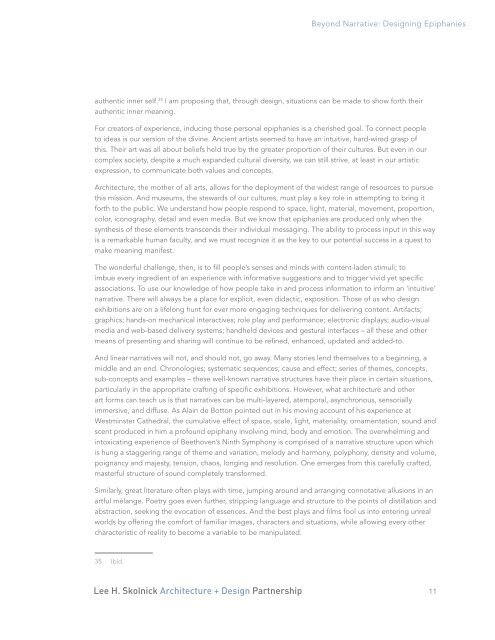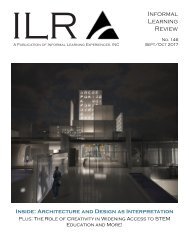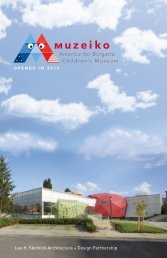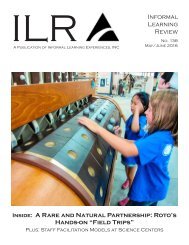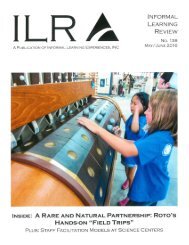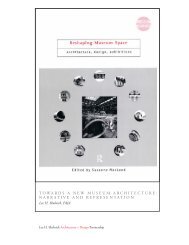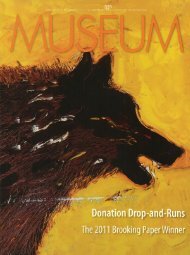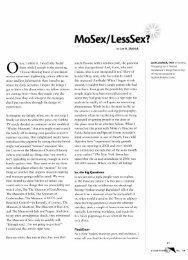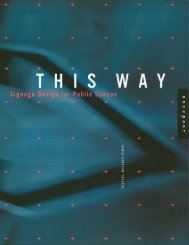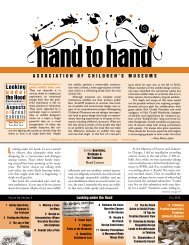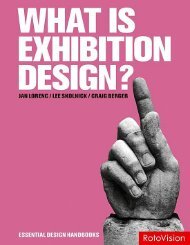Beyond Narrative
- No tags were found...
You also want an ePaper? Increase the reach of your titles
YUMPU automatically turns print PDFs into web optimized ePapers that Google loves.
<strong>Beyond</strong> <strong>Narrative</strong>: Designing Epiphanies<br />
authentic inner self. 35 I am proposing that, through design, situations can be made to show forth their<br />
authentic inner meaning.<br />
For creators of experience, inducing those personal epiphanies is a cherished goal. To connect people<br />
to ideas is our version of the divine. Ancient artists seemed to have an intuitive, hard-wired grasp of<br />
this. Their art was all about beliefs held true by the greater proportion of their cultures. But even in our<br />
complex society, despite a much expanded cultural diversity, we can still strive, at least in our artistic<br />
expression, to communicate both values and concepts.<br />
Architecture, the mother of all arts, allows for the deployment of the widest range of resources to pursue<br />
this mission. And museums, the stewards of our cultures, must play a key role in attempting to bring it<br />
forth to the public. We understand how people respond to space, light, material, movement, proportion,<br />
color, iconography, detail and even media. But we know that epiphanies are produced only when the<br />
synthesis of these elements transcends their individual messaging. The ability to process input in this way<br />
is a remarkable human faculty, and we must recognize it as the key to our potential success in a quest to<br />
make meaning manifest.<br />
The wonderful challenge, then, is to fill people’s senses and minds with content-laden stimuli; to<br />
imbue every ingredient of an experience with informative suggestions and to trigger vivid yet specific<br />
associations. To use our knowledge of how people take in and process information to inform an ‘intuitive’<br />
narrative. There will always be a place for explicit, even didactic, exposition. Those of us who design<br />
exhibitions are on a lifelong hunt for ever more engaging techniques for delivering content. Artifacts;<br />
graphics; hands-on mechanical interactives; role play and performance; electronic displays; audio-visual<br />
media and web-based delivery systems; handheld devices and gestural interfaces – all these and other<br />
means of presenting and sharing will continue to be refined, enhanced, updated and added-to.<br />
And linear narratives will not, and should not, go away. Many stories lend themselves to a beginning, a<br />
middle and an end. Chronologies; systematic sequences; cause and effect; series of themes, concepts,<br />
sub-concepts and examples – these well-known narrative structures have their place in certain situations,<br />
particularly in the appropriate crafting of specific exhibitions. However, what architecture and other<br />
art forms can teach us is that narratives can be multi-layered, atemporal, asynchronous, sensorially<br />
immersive, and diffuse. As Alain de Botton pointed out in his moving account of his experience at<br />
Westminster Cathedral, the cumulative effect of space, scale, light, materiality, ornamentation, sound and<br />
scent produced in him a profound epiphany involving mind, body and emotion. The overwhelming and<br />
intoxicating experience of Beethoven’s Ninth Symphony is comprised of a narrative structure upon which<br />
is hung a staggering range of theme and variation, melody and harmony, polyphony, density and volume,<br />
poignancy and majesty, tension, chaos, longing and resolution. One emerges from this carefully crafted,<br />
masterful structure of sound completely transformed.<br />
Similarly, great literature often plays with time, jumping around and arranging connotative allusions in an<br />
artful mélange. Poetry goes even further, stripping language and structure to the points of distillation and<br />
abstraction, seeking the evocation of essences. And the best plays and films fool us into entering unreal<br />
worlds by offering the comfort of familiar images, characters and situations, while allowing every other<br />
characteristic of reality to become a variable to be manipulated.<br />
35 Ibid.<br />
11


